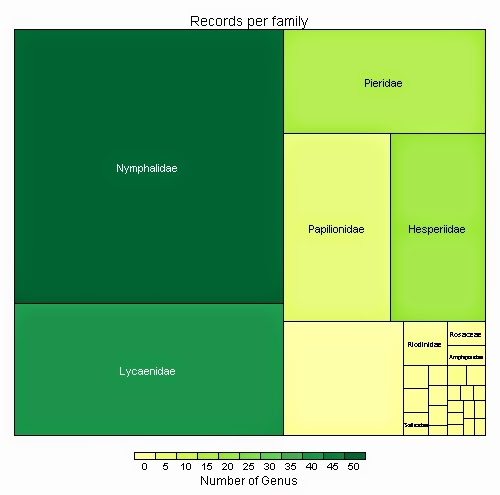iNaturalist is a specialized biodiversity portal. Some people call it Faacebook for Biodiversity lovers. The portal lets us post records in the form of photos, other members can help us identify them and the data is made available to wider audience through portals like Global Biodiversity Information Facility (GBIF) and Encyclopedia of Life (EOL).
We have been posting records of butterflies on the ButterflyIndia project on iNaturalist for some time and now we have reached a significant mark. We now have 1000 records covering more than 250 taxa. We are in a process of making all the records Research Grade meaning verified by at least one other member than the one who has posted it. These records complete with what, when, where and by whom. So these records can be quickly mapped or analysed in different ways. The opportunities are unlimited.
These kind of projects help us build data on larger scale and help us understand our biodiversity better. Since the data is made available on several international portals, in some sense our records become immortal and would be preserved for a very long time.
Now we need help. You can help us in following ways:
We have been posting records of butterflies on the ButterflyIndia project on iNaturalist for some time and now we have reached a significant mark. We now have 1000 records covering more than 250 taxa. We are in a process of making all the records Research Grade meaning verified by at least one other member than the one who has posted it. These records complete with what, when, where and by whom. So these records can be quickly mapped or analysed in different ways. The opportunities are unlimited.
Map showing locations of first 1000 records on ButterflyIndia project
These kind of projects help us build data on larger scale and help us understand our biodiversity better. Since the data is made available on several international portals, in some sense our records become immortal and would be preserved for a very long time.
Now we need help. You can help us in following ways:
- By posting more records for different species and different regions. You can see in the map where we have data and where are the gaps.
- Requesting and helping more members to convert their photographs into re-usable records to help research and conservation
- Helping confirm identifications to get more records to research grade. We need lot of help here, we have many records yet to be confirmed.
- By simply encouraging members who are posting records by comments on the records
Starting the contributions is very simple, login into iNaturalist website using any id like Google, Facebook, Yahoo etc. and get going. So now start digging in your photo archive and start posting records, help identify and confirm identifications for others.
We seek your feedback on this project. We would like to hear form you about:
Here are some more examples of quick analysis and visualizations of this data we did in under half an hour.
We seek your feedback on this project. We would like to hear form you about:
- How can we attract more contributions on such portals?
- How can we address the need for identification confirmations?
- Do you find such activities useful at all?
- What long term contributions you see these portals making?
Here are some more examples of quick analysis and visualizations of this data we did in under half an hour.
Each dot represents a day and each year is represented in concentric circles. Blue color represents less records on the day and red represents more.
Families represented in our data. Larger the box, more records we have.
Each line represents a calender day of year and length represents number of records on that day.
Same as above aggregated monthly
Same as above aggregated weekly
Each square represents approximately one degree by one degree area (~110x110km) and color represents number of records form that region.
Data extraction using package rinat and visualizations created using package bdvis in R. More examples and sample code can be found at http://vijaybarve.wordpress.com/tag/r/
- Barve, V., & Hart, E. (2014). rinat: Access iNaturalist data through APIs. R package. Retrieved from http://cran.r-project.org/package=rinat
- Barve, V. (2014). bdvis: Biodiversity Data Visualizations. Retrieved from https://github.com/vijaybarve/bdvis








Subhajit Roy of Facebook:
ReplyDelete1. By quick authentic identifications, discussions increasing our know how about the particular specie
2. By inviting an expert(s) for each taxonomic group who would confirm the identity in that taxa...
4. these portals would help us map the observations and distributions of individual specie.
Do you track their migrations?
ReplyDeleteCan you use it to track the pesticides they come in contact with?
ReplyDeleteOr can you use it to track an increase or decrease in populations due to global warming?
Thank you for all your hard work!!
Interesting thoughts Francis. Yes this can very well be used for tracking migrations once we have sufficient data and in a few years global warming trends too.
ReplyDelete